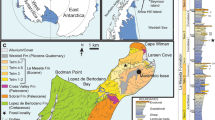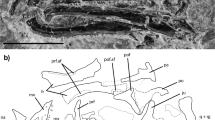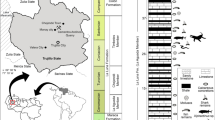Abstract
New fossils from the Upper Permian Moradi Formation of northern Niger1,2,3,4,5,6 provide an insight into the faunas that inhabited low-latitude, xeric environments near the end of the Palaeozoic era (∼ 251 million years ago). We describe here two new temnospondyl amphibians, the cochleosaurid Nigerpeton ricqlesi gen. et sp. nov. and the stem edopoid Saharastega moradiensis gen. et sp. nov., as relicts of Carboniferous lineages that diverged 40–90 million years earlier7,8,9. Coupled with a scarcity of therapsids, the new finds suggest that faunas from the poorly sampled xeric belt that straddled the Equator during the Permian period10,11,12 differed markedly from well-sampled faunas that dominated tropical-to-temperate zones to the north and south13,14,15. Our results show that long-standing theories of Late Permian faunal homogeneity are probably oversimplified as the result of uneven latitudinal sampling.
This is a preview of subscription content, access via your institution
Access options
Subscribe to this journal
Receive 51 print issues and online access
$199.00 per year
only $3.90 per issue
Buy this article
- Purchase on Springer Link
- Instant access to full article PDF
Prices may be subject to local taxes which are calculated during checkout



Similar content being viewed by others
References
Ministère des Mines et de l'Hydraulique, Direction des Mines et de la Géologie. Afasto, Carte Géologique 1:200,000, Notice Explicative (1977).
Taquet, P. Un exemple de datation et de corrélation stratigraphique basé sur les Captorhinomorphes (Reptiles cotylosauriens). Mém. Bureau Recherch. Géol. Min. 77, 407–409 (1972)
de Ricqlès, A. & Taquet, P. La faune de vertébrés du Permien Supérieur du Niger. I. Le captorhinomorphe Moradisaurus grandis (Reptilia, Cotylosauria). Ann. Paléontol. 68, 33–106 (1982)
Sidor, C. A., Blackburn, D. C. & Gado, B. The vertebrate fauna of the Upper Permian of Niger. II. Preliminary description of a new pareiasaur. Palaeontol. Afr. 39, 45–52 (2003)
O'Keefe, F. R., Sidor, C. A., Larsson, H. C. E., Maga, A. & Ide, O. The vertebrate fauna of the Upper Permian of Niger. III. Ontogeny and morphology of the hindlimb of Moradisaurus grandis (Captorhinidae: Moradisaurinae). J. Vert. Paleontol. (in the press)
Taquet, P. Géologie et Paléontologie du Gisement de Gadoufaoua (Aptien du Niger) 1–191 (Cahiers de Paléontologie, Paris, 1976)
Sequeira, S. E. K. The skull of Cochleosaurus bohemicus, a temnospondyl from the Czech Republic (Upper Carboniferous) and cochleosaurid interrelationships. Trans. R. Soc. Edinb. Earth Sci. 94, 21–43 (2004)
Milner, A. R. & Sequeira, S. E. K. A cochleosaurid temnospondyl amphibian from the Middle Pennsylvanian of Linton, Ohio, U.S.A. Zool. J. Linn. Soc. 122, 261–290 (1998)
Milner, A. R. in Palaeozoic vertebrate biostratigraphy and biogeography (ed. Long, J. A.) 324–353 (Belhaven, London, 1993)
Gibbs, M. T. et al. Simulations of Permian climate and comparisons with climate-sensitive sediments. J. Geol. 110, 33–55 (2002)
Rees, P. M. et al. Permian phytogeographic patterns and climate data/model comparisons. J. Geol. 110, 1–31 (2002)
Ziegler, A. M., Hulver, M. L. & Rowley, D. B. in Late Glacial and Postglacial Environmental Changes (ed. Martini, I. P.) 111–146 (Oxford Univ. Press, New York, 1997)
Rubidge, B. S. & Sidor, C. A. Evolutionary patterns among Permo–Triassic therapsids. Annu. Rev. Ecol. Syst. 32, 449–480 (2001)
Battail, B. A comparison of Late Permian Gondwanan and Laurasian amniote faunas. J. Afr. Earth Sci. 31, 165–174 (2000)
Modesto, S. P. & Rybczynski, N. in The Age of Dinosaurs in Russia and Mongolia (eds Benton, M. J., Shishkin, M. A., Unwin, D. M. & Kurochkin, E. N.) 17–34 (Cambridge Univ. Press, New York, 2000)
Bakker, R. T. Anatomical and ecological evidence of endothermy in dinosaurs. Nature 238, 81–85 (1972)
Damiani, R. J. A systematic revision and phylogenetic analysis of Triassic mastodonsauroids (Temnospondyli: Stereospondyli). Zool. J. Linn. Soc. 133, 379–482 (2001)
Yates, A. M. & Warren, A. A. The phylogeny of the ‘higher’ temnospondyls (Vertebrate: Choanata) and its implications for the monophyly and origins of the Stereospondyli. Zool. J. Linn. Soc. 128, 77–121 (2000)
Schoch, R. R. & Milner, A. R. in Encyclopedia of Paleoherpetology (ed. Wellnhofer, P.) Part 3B, 1–203 (Verlag Dr. Friedrich Pfeil, Munich, 2000)
Dias, E. V. & Barberena, M. C. A temnospondyl amphibian from the Rio do Rasto Formation, Upper Permian of southern Brazil. An. Acad. Bras. Cienc. 73, 135–143 (2001)
Marsicano, C. A. & Warren, A. A. The first Palaeozoic rhytidosteid record: Trucheosaurus major Watson, 1956 from the Late Permian of Australia, and a reassessment of the Rhytodosteidae (Amphibia: Temnospondyli). Bull. Brit. Mus. Nat. Hist. (Geol.) 54, 147–154 (1998)
Angielczyk, K. D. & Kurkin, A. A. Phylogenetic analysis of Russian Permian dicynodonts (Therapsida: Anomodontia): implications for Permian biostratigraphy and Pangaean biogeography. Zool. J. Linn. Soc. 139, 157–212 (2003)
Lucas, S. G. in Carboniferous and Permian of the World (eds Hills, L. V., Henderson, C. M. & Bamber, E. W.) 479–491 (Canadian Society of Petroleum Geologists Memoir 19, Calgary, Alberta, 2002)
Jalil, N.-E. Continental Permian and Triassic vertebrate localities from Algeria and Morocco and their stratigraphical correlations. J. Afr. Earth Sci. 29, 219–226 (1999)
Acknowledgements
We thank A. Beck, D. Blackburn, J. Conrad, A. Dindine, E. Duneman, B. Gado, T. Lyman, G. Lyon, R. Sadlier and G. Wilson for assistance in the field; A. Crean, E. Love, V. Heisey and J. Groenke for fossil preparation; and S. Spilkevitz for help with Fig. 3. We thank H. Salissou of the Ministère des Enseignements Secondaire et Supérieur, de la Recherche et de la Technologie for permission to conduct fieldwork. We acknowledge the National Geographic Society for support.
Author information
Authors and Affiliations
Corresponding author
Ethics declarations
Competing interests
The authors declare that they have no competing financial interests.
Supplementary information
Supplementary Data
This file contains the list of characters used in the cladistic analysis of temnospondyl relationships, and the corresponding character-taxon data matrix. (DOC 31 kb)
Rights and permissions
About this article
Cite this article
Sidor, C., O'Keefe, F., Damiani, R. et al. Permian tetrapods from the Sahara show climate-controlled endemism in Pangaea. Nature 434, 886–889 (2005). https://doi.org/10.1038/nature03393
Received:
Accepted:
Issue Date:
DOI: https://doi.org/10.1038/nature03393
This article is cited by
-
The phylogeny of early amniotes and the affinities of Parareptilia and Varanopidae
Nature Ecology & Evolution (2019)
-
Interrelationships, palaeobiogeography and early evolution of Stereospondylomorpha (Tetrapoda: Temnospondyli)
Journal of Iberian Geology (2019)
-
Physical and environmental drivers of Paleozoic tetrapod dispersal across Pangaea
Nature Communications (2018)
-
New Permian fauna from tropical Gondwana
Nature Communications (2015)
Comments
By submitting a comment you agree to abide by our Terms and Community Guidelines. If you find something abusive or that does not comply with our terms or guidelines please flag it as inappropriate.



